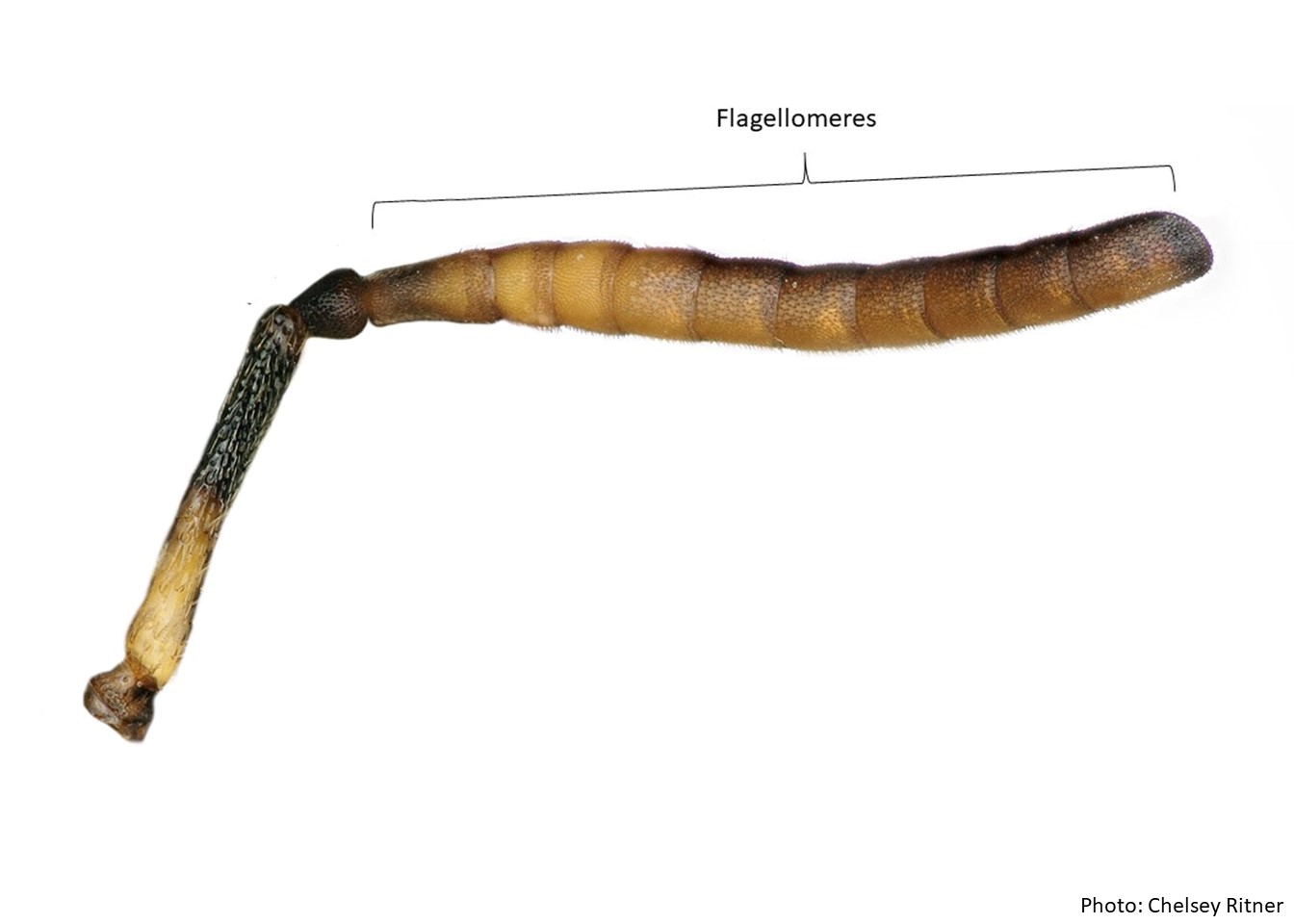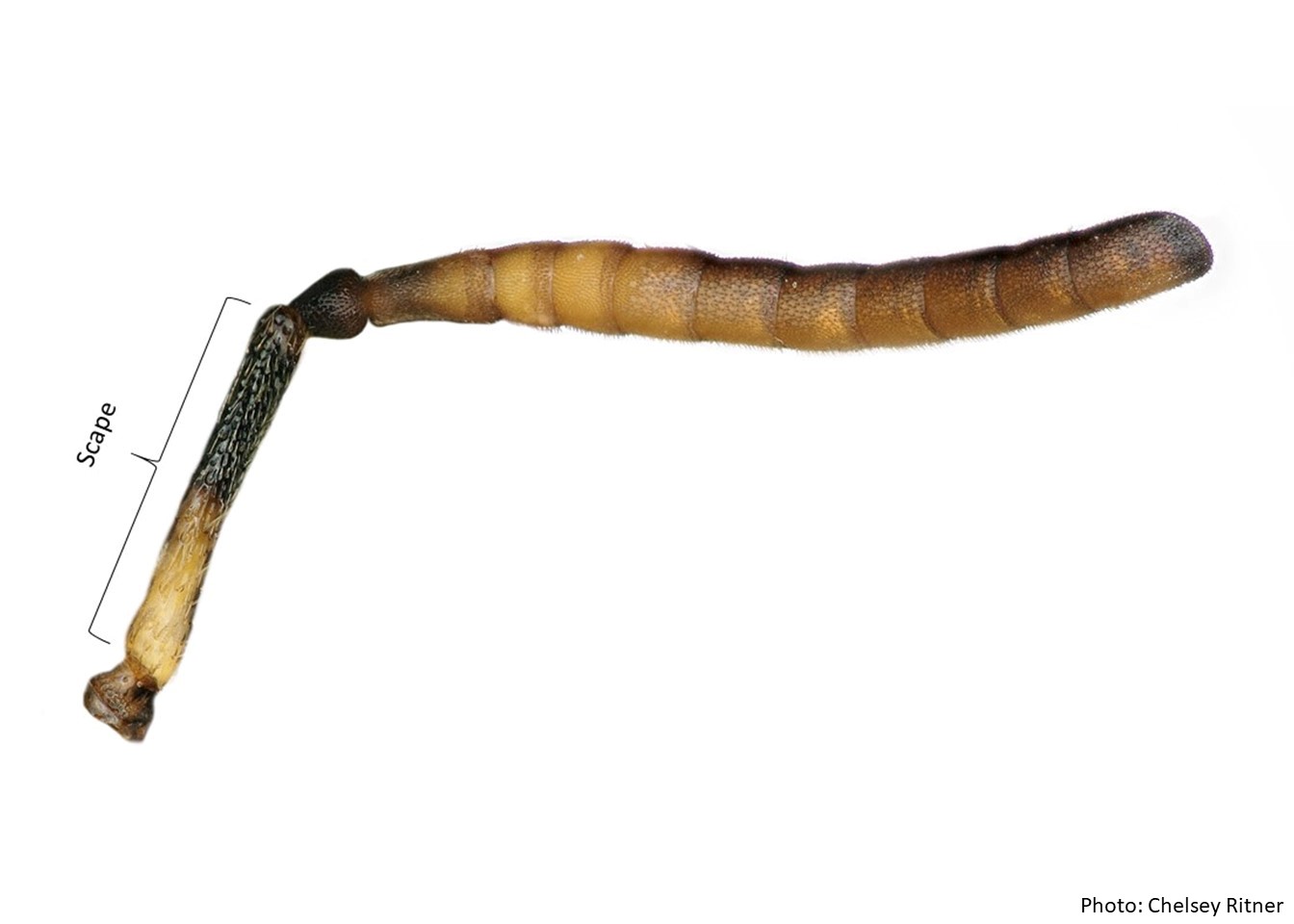Family: Megachilidae
Subfamily: Megachilinae
Tribe: Megachilini
Genus: Thaumatosoma Smith, 1865
Common name: none
Thaumatosoma are robust bees that range in body length from 9–12 mm (Michener 2007Michener 2007:
Michener, C.D. 2007. The Bees of the World (2nd ed.). Johns Hopkins University Press, Baltimore and London, 953 pp.). Thaumatosoma was elevated from a subgenus of Megachile to genus status by Gonzalez et al. (2019).
(modified from King and Exley 1985King and Exley 1985:
King, J. and E.M. Exley. 1985. A revision of Chalicodoma (Chalicodomoides) Michener (Hymenoptera: Megachilidae). Journal of the Australian Entomological Society 24: 187-204; Michener 2007Michener 2007:
Michener, C.D. 2007. The Bees of the World (2nd ed.). Johns Hopkins University Press, Baltimore and London, 953 pp.)
 with round basolateral shoulders and concave laterallateral:
with round basolateral shoulders and concave laterallateral: attenuate.
attenuate. is distinctly swollen and the last two flagellomeres are flattened and strongly expanded.
is distinctly swollen and the last two flagellomeres are flattened and strongly expanded.Thaumatosoma may be confused with bees within the genus Hackeriapis due to the shared characteristics of postgradular grooves on T2–T3 and expanded apicalapical:
near or at the apex or end of any structure
flagellar segments in some Hackeriapis males (Michener 2007Michener 2007:
Michener, C.D. 2007. The Bees of the World (2nd ed.). Johns Hopkins University Press, Baltimore and London, 953 pp.). Female Thaumatosoma can be differentiated from Hackeriapis by their bidentatebidentate:
having two teeth
mandible and T6T6:
the segments on the top side of the abdomen, often abbreviated when referring to a specific segment to T1, T2, T3, T4, T5, T6, or T7 with round basolateral shoulders (Michener 2007Michener 2007:
with round basolateral shoulders (Michener 2007Michener 2007:
Michener, C.D. 2007. The Bees of the World (2nd ed.). Johns Hopkins University Press, Baltimore and London, 953 pp.). Male Thaumatosoma can be differentiated from Hackeriapis by the uniquely swollen scapescape:
the basal, and usually the longest, segment of the antennae , expanded apicalapical:
, expanded apicalapical:
near or at the apex or end of any structure
flagella, and long, coarse bristles in the center of the clypeusclypeus:
a section of the face below the antennae, demarcated by the epistomal sutures (Michener 2007Michener 2007:
Michener, C.D. 2007. The Bees of the World (2nd ed.). Johns Hopkins University Press, Baltimore and London, 953 pp.).
Thaumatosoma are known to visit flowers of plants in the families Goodeniaceae and Myoporaceae (King and Exley 1985King and Exley 1985:
King, J. and E.M. Exley. 1985. A revision of Chalicodoma (Chalicodomoides) Michener (Hymenoptera: Megachilidae). Journal of the Australian Entomological Society 24: 187-204).
Nesting behavior is unknown.
Thaumatosoma consists of two species (Michener 2007Michener 2007:
Michener, C.D. 2007. The Bees of the World (2nd ed.). Johns Hopkins University Press, Baltimore and London, 953 pp.); none are known to occur in the U.S. or Canada.
There are no known invasives.
Thaumatosoma occurs throughout the southern third of Australia. They are found predominantly along the western coast as well as inland areas with desert-like conditions (Michener 2007Michener 2007:
Michener, C.D. 2007. The Bees of the World (2nd ed.). Johns Hopkins University Press, Baltimore and London, 953 pp.).

Distribution map generated by Discover Life -- click on map for details, credits, and terms of use.
King, J. and E.M Exley. 1985. A reinstatement and revision of the genus Thaumatosoma Smith (Apoidea: Megachilidae). Australian Journal of Entomology 24(2): 87-92.
Gonzalez, V.H., G.T. Gustafson, and M.S. Engel. 2019. Morphological phylogeny of Megachilini and the evolution of leaf-cutter behavior in bees (Hymenoptera: Megachilidae). Journal of Melittology 85: 1-123.
Michener, C.D. 2007. The Bees of the World (2nd ed.). Johns Hopkins University Press, Baltimore and London, 953 pp.